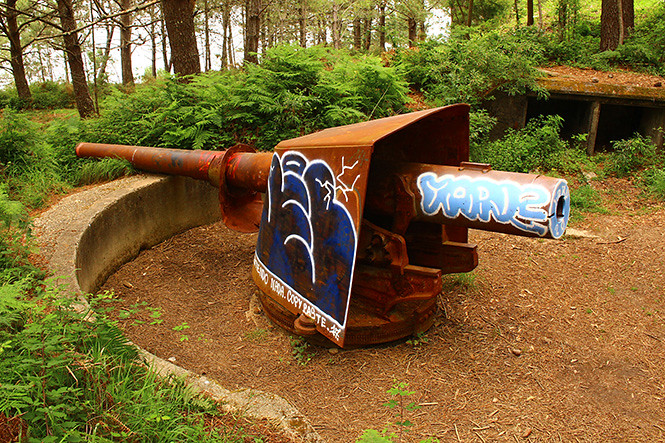The two Munáiz-Argüelles cannons of the Battery J-3 of Monteferro, in the Vigo Estuary
During the Spanish Civil War, the region of Galicia, controlled by the national side, had two of the best defended coasts in the world.
The first of these stretches of coast was the Ártabro Gulf, which covers the Ferrol, Betanzos and Burgo estuaries, due to the naval base of the Spanish Navy in Ferrol and the important port of La Coruña. The second section was in the Rías Bajas, with six batteries: the J-1 Puerto Cuaces and the J-2 Cabo Udra, both guarding the exit of the Pontevedra estuary, and the J-3 de Monteferro, the J-4 of Cabo Silleiro Alto, the J-5 by Silleiro Bajo and the J-6 de La Guía, guarding the Vigo Estuary, since the city of Vigo had one of the most important ports on the national side, a great arrival point for weapons and supplies.
I have already spoken a few times here about the J-3 Battery of Monteferro. This battery was installed in 1936, at the beginning of the Spanish Civil War, on the Monteferro peninsula, located in the southern bank of the Ría de Vigo and in the municipality of Nigrán (Pontevedra). It was equipped with three Munáiz-Argüelles 150/45 Model 1903 rapid-fire cannons, pieces with a range of 13 km that were brought from Ferrol. The battery was active until the 1960s, when it went into reserve, but remained as a military installation until May 4, 1989, when it was abandoned and the Ministry of Defense gave the land to the mountain community.
The battery preserves two of its three original cannons. The third cannon was donated by the Army to the Cotobade City Council, where it was displayed until 2004, being later sent to a municipal plot, from where It was recovered by the Brigade "Galicia" VII (BRILAT) in 2015.
In July 2023, the Nigrán City Council carried out carried out a restoration process of these cannons, with funds from the Provincial Council of Pontevedra. The two surviving cannons (pieces 1 and 3 of the old battery) have been painted naval gray, as you can see in this video:
In May 2008 I published these photos of the cannons, then rusty and surrounded by weeds:



Between 2016 and 2017, the cannons were vandalized with graffiti, in the midst of a total abandonment of this battery.


In June 2017, the urban explorer Manuel Calavera restored one of the cannons, No. 32, which occupies well number 1 of the battery, the northernmost. He drew a characteristic shark mouth that looked very good.

However, over the years this canyon became degraded again. You can see here a series of photos of how they look now. Here we see piece number 1:





And here we can see piece number 3, which unlike the other two, did not have a well:




In addition, the City Council and the Provincial Council have placed an information panel about the history of this battery. Unfortunately, it is only in Galician (to put things in Spanish must be something beyond them).

Por lo demás, los edificios de la batería siguen en ruinas y cubiertos de grafitis. Su aspecto es lamentable.




You can see more photos here.
|
Don't miss the news and content that interest you. Receive the free daily newsletter in your email: Click here to subscribe |
- Lo más leído
- A large collection of Volkswagen cars hidden in an abandoned mine in Switzerland
- Sabbione: a beautiful Swiss town that looks like something out of 'The Lord of the Rings'
- The 'Bomber Glacier': The wreckage of a B-29 on a remote mountain of Alaska
- Ikeshima, a semi-abandoned Japanese island that has post-apocalyptic landscapes
- An old Soviet military plane abandoned from 1971 on a Russian island near Alaska
- The supermassive black hole of Phoenix A, the biggest known light-devouring monster
- The MRU, a mysterious underground city of nazi Germany with 80 km of tunnels

 ES
ES






Opina sobre esta entrada: